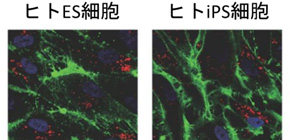
Efficient induction of vascular endothelial cells from human pluripotential stem cells (hPSCs) using extracellular matrix (ECM)s
There are about 37 trillion cells of 200 different types in the human body, with individual cells forming tissues and organs. Many cells exist in the extracellular matrix (ECM), a large bed of molecules of proteins and sugar, either in an orderly manner or scattered. There are many types of ECMs, so the diversity in tissues and organs, such as muscle, liver, and blood vessels, is attributed to the diversity in cells and ECMs.
Some ECMs such as collagen provide structural and biochemical support in order to promote cell survival and proliferation, and there is a type of ECM specific to each cell type. However, research focusing on the ECM not only as support provided for cells but also as a factor for controlling the fate of a cell in its differentiation has rarely been conducted.
A joint group of researchers from the Center for iPS Cell Research and Application, Kyoto University, and the Institute for Protein Research, Osaka University, succeeded in developing a method for efficient differentiation of functional vascular endothelial cells (ECs) from hPSCs by using a short fragment of laminin 411 (LM411-E8), an ECM.
This group also clarified that signal transduction through adhesion of PSC-MPCs onto LM411-E8 played an important role in the fate determination of endothelial progenitor cells during endothelial differentiation from mesodermal progenitors.
Furthermore, this group established an efficient differentiation of functional vascular ECs from hPSCs by combining LM411-E8 with low-molecular compounds, achieving a feeder-free differentiation system that does not involve the use of animal-derived components. ECs differentiated by this method achieved tube formation both in vitro and in vivo , presenting vascularization perfused with mouse blood.
From the practical perspective of application of hPSCs, induction of highly purified vascular ECs that was achieved by this group will lead to the development of regenerative medicine and analytical studies of various diseases. In addition, this group’s study is significant in that it clarified the partial role of ECMs.
ECMs that abundantly exist in the body from early in development and over the course of one's life have no small effect on the fate determination of cells in various tissues. As this study showed in the example of differentiation of vascular endothelial cells, iPS cells will be helpful in clarifying mechanisms of ECMs in various tissues. It is hoped that these research results will be utilized in the development of regenerative medicine using iPS cells.
Abstract
Obtaining highly purified differentiated cells via directed differentiation from human pluripotent stem cells (hPSCs) is an essential step for their clinical application. Among the various conditions that should be optimized, the precise role and contribution of the extracellular matrix (ECM) during differentiation are relatively unclear. Here, using a short fragment of laminin 411 (LM411-E8), an ECM predominantly expressed in the vascular endothelial basement membrane, we demonstrate that the directed switching of defined ECMs robustly yields highly-purified (>95%) endothelial progenitor cells (PSC-EPCs) without cell sorting from hPSCs in an integrin-laminin axis-dependent manner. Single-cell RNA-seq analysis revealed that LM411-E8 resolved intercellular transcriptional heterogeneity and escorted the progenitor cells to the appropriate differentiation pathway. The PSC-EPCs gave rise to functional endothelial cells both in vivo and in vitro. We therefore propose that sequential switching of defined matrices is an important concept for guiding cells towards desired fate.
Figure 1
Figure 2
Figure 3
Figure 4
Figure 5
Figure 6
To learn more about this research, please view the full research report entitled “ Laminin-guided highly efficient endothelial commitment from human pluripotent stem cells ” at this page of the Scientific Reports website.
Related link

